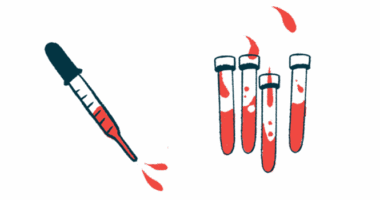PNH combination therapy safe, allows less frequent dosing: Study
Pairing of pozelimab and cemdisiran also keeps hemolysis under control

An experimental combination of pozelimab and cemdisiran was found to be safe in adults with paroxysmal nocturnal hemoglobinuria (PNH) and to keep hemolysis under control — even with less frequent dosing, according to a study. Hemolysis is the premature breakdown of red blood cells.
The Phase 2 clinical study (NCT04811716) tested how safe cemdisiran is and how well it works when given every four weeks in combination with pozelimab — given at a frequency of every two or every four weeks. The study included 24 patients.
The study, “Safety, Efficacy, and Patient-Reported Outcomes From a Phase 2 Randomized Trial of Pozelimab and Cemdisiran Combination in Patients With Paroxysmal Nocturnal Hemoglobinuria,” was published in the journal eJHaem.
It was funded by Regeneron Pharmaceuticals, the company that is developing pozelimab for PNH and other complement-mediated diseases. Its use in combination with cemdisiran, which is being developed by Alnylam Pharmaceuticals, is being tested under an agreement between the two companies.
“This study provides promising results for the potential use of pozelimab and cemdisiran combination therapy in the treatment of PNH, and supports the dose utilized in the ongoing Phase 3 clinical development program,” wrote the researchers in reference to ACCESS-1 (NCT05133531) and its follow-up extension, ACCESS-EXT (NCT05744921).
Drugs combine complementary mechanisms to target C5 protein
In PNH, red blood cells become susceptible to hemolysis driven by the overactivation of the complement system, a group of proteins that normally function as part of the immune system to protect the body against infection. Hemolysis can occur inside or outside blood vessels, leading to a range of symptoms.
Complement inhibitors like Ultomiris (ravulizumab-cwvz) and Soliris (eculizumab) help control hemolysis by blocking the action of C5, a protein in the complement system. However, not all patients respond well to these medications, and many keep experiencing symptoms and require blood transfusions within the first months of treatment.
Used together, pozelimab and cemdisiran combine two complementary mechanisms to target C5. As an antibody, pozelimab blocks the action of C5, while cemdisiran is a small interfering RNA molecule that reduces the production of C5 in the liver. Pozelimab is approved under the brand name Veopoz to treat CHAPLE disease, a complement-mediated disorder.
Combination therapy generally well tolerated
In the study, patients who were already taking pozelimab were given cemdisiran as well. They were divided into two groups, one where pozelimab was administered every four weeks, and another where pozelimab was given every two weeks. In both groups, cemdisiran was administered every four weeks. The two therapies were given via subcutaneous injections.
Over about seven months, lactate dehydrogenase (LDH) levels were kept within safe boundaries in most patients. LDH is an enzyme that is released into the bloodstream when red blood cells are destroyed, so keeping LDH levels low means the treatment is working to stop hemolysis.
Almost all patients avoided blood transfusions, which are often necessary when anemia is severe.
Combination treatment maintained adequate hemolysis control and was generally well tolerated.
About two-thirds of patients had some side effects during treatment, but these were mostly mild or moderate. Importantly, no one developed serious infections or blood clots during the study, and no one died. None of the patients discontinued treatment due to side effects.
Patients also reported feeling less tired, being more active, and having a better overall quality of life while on the treatment.
One important finding was that giving pozelimab every two weeks didn’t improve results compared with giving it every four weeks. Less frequent dosing was just as effective and could make treatment easier for patients.
“Combination treatment maintained adequate hemolysis control and was generally well tolerated,” the researchers wrote.









